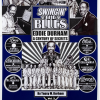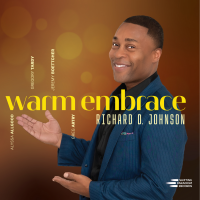Under the Radar
Under the Radar is about jazz and creative music legends who have taken less-travelled paths. It's about relative unknowns and journeymen doing extraordinary, and sometimes under-recognized work; it's also about pioneers--the ones out front and those behind the scenes, experimenting with new ideas.
Eddie Durham: The Jazz Innovator a City Refuses to Forget

by Hank Hehmsoth
Eddie Durham's LegacyFew names in jazz carry the quiet weight of Eddie Durham. Born in San Marcos, Texas, in 1906, Durham was a trombonist, guitarist, composer, and arranger whose fingerprints are all over the sound of swing. He was a pioneering electric guitarist--the first to record with the instrument--and a key arranger for Bennie Moten, Jimmie Lunceford, Count Basie, and Glenn Miller. Durham helped shape the Count Basie Orchestra's small-group feel, expanded orchestral voicings in ways that gave the band ...
Continue ReadingA Different Drummer, Pt. 8: Ustad Zakir Hussain Talks Tabla

by Karl Ackermann
Origins of the Tabla The twin hand drum was developed in its current form about 300 years ago on the Indian subcontinent but the roots of the tabla may date to pre-Muslim, Arabia. The name comes from “tabl," the Arabic word for drum, and temple carvings of tabla-like double-hand drums date to 500 BCE. Tabla is commonly used in India, Bangladesh, Pakistan, Nepal, Afghanistan, and Sri Lanka. The drum's use crosses most genres in that region; it is used in ...
Continue ReadingA Different Drummer, Pt. 7: Rudy Royston’s Higher Calling

by Karl Ackermann
A look at Rudy Royston's resume tells you that the drummer should be more recognized. Royston has racked up credits with Nate Wooley, Jon Irabagon, Tom Harrell, Aruán Ortiz, Rudresh Mahanthappa, Bill Frisell, JD Allen, Dr. Lonnie Smith, Ron Miles, Noah Preminger, Ben Allison, Tim Ries, Alex Sipiagin, Linda May Han Oh, Bruce Barth, Don Byron, Jenny Scheinman, Dave Douglas, and dozens of other top musicians. Royston's association with Douglas led to his first leader album, 303 (Greenleaf Music, 2014) ...
Continue ReadingCharu Suri: The Jazz Raga

by Karl Ackermann
The Roots of Indo-JazzJazz and Indian ragas share common ground in their traditional use of improvisation. They are often talked about in compatible terms, but Ravi Shankar, for one, did not believe that ragas could be compared to jazz improvisation. Spontaneous creation in jazz differs from the complex rhythmic structural patterns of Indian improvisation. Shankar became the embodiment of non-western music in the 1960s. Jazz enthusiasts filled his audiences, quickly adapting techniques without any serious degree of due diligence. Nevertheless, ...
Continue ReadingA Different Drummer, Pt. 6: Iberian Beats – Jorge Rossy & Pedro Melo Alves

by Karl Ackermann
The music of the Iberian Peninsula is as rich and diverse as any in the world. Its influences are many yet it developed in the pre-global bubble of geography. Early music of the peninsula was impacted by much of the known world in the primeval period and the Middle Ages. The peninsula was isolated by the Pyrenees Mountains effectively blocking off modern Spain and Portugal from the rest of Europe but cultural aspects of the Roman Empire, Turkic tribes, and ...
Continue ReadingIll Considered - Reconsidered

by Karl Ackermann
London Calling, AgainAround 2010, the South London jazz scene began breaking with tradition for an alternative union of music rooted in global cultures. It represented a fundamental change in the way young Londoners related to music; the rhythms were infused with hip hop, spiritual jazz, dubstep, funk, groove, reggae, and future soul in various combinations. In no small part, jazz was returning to its creators; repurposed for a new world culture. The French-born DJ/Producer Gilles Jérôme Moehrle (aka ...
Continue ReadingA Different Drummer, Part 5: Terri Lyne Carrington

by Karl Ackermann
In her 2003 Carnegie Mellon University paper Experience West African Drumming: A Study of West African Dance-Drumming and Women Drummers, Leslie Marie Mullins explains that drumming was explicitly the territory of male musicians in West Africa. Mullins reveals that several myths were employed to keep women and drums far apart. Among them, Ghanaian women were thought (by males) to lack the physical strength for the strenuous activity of drumming, and they were taught that drumming would lead to infertility. But ...
Continue ReadingA Different Drummer, Part 4: The Zildjian Legacy

by Karl Ackermann
They are the oldest family-owned business in the world, recognized globally by musicians from every genre. The Avedis Zildjian Company—known simply as Zildjian —traces its history to the ancient cymbals of the Middle East and Asia. Almost four hundred years ago, Avedis, an Armenian metalsmith and alchemist in seventeenth-century Istanbul, discovered an alloy of tin, copper, and silver with unique sound qualities. In 1618 he was using his secret amalgam to create cymbals of remarkable precision and resonance. Working in ...
Continue ReadingA Different Drummer, Part 3: Pino Basile & Mizuki Wildenhahn

by Karl Ackermann
The Swish Knocker, And More Early on in his career, the late Milford Graves abandoned the snare drum, substituting the resonance of the toms for the snare parts. He believed music of the drum reverberated from within the drummer and the listener without the need for extraneous instrumentation. Tyshawn Sorey's approach to music speaks to contempt for classification. His kit is often a vast collection of tuned and untuned percussion; cymbals, gongs, bells, shakers, and paraphernalia that almost obscure the ...
Continue ReadingA Different Drummer, Part 2: Royal Hartigan

by Karl Ackermann
Drums of Life--Drums of DeathThe ruins of the Anasazi people stand undisturbed in the cliffs between the high mesas and the canyon floors of the southwest. Dating to 2500 B.C., the multi-story adobe pueblos and stone cities were the sites of the ancient indigenous peoples of North America. Archeologists have uncovered an assortment of percussion instruments in the ruins: suspended stones that resonated when struck, gourd rattles with seeds inside. Rasps were pieces of wood or bone with serrated edges ...
Continue Reading























